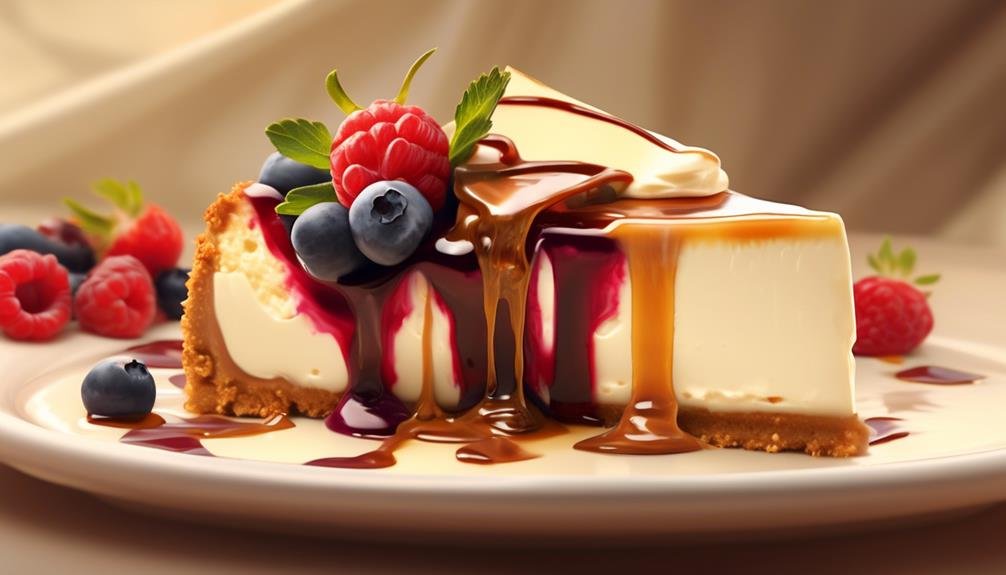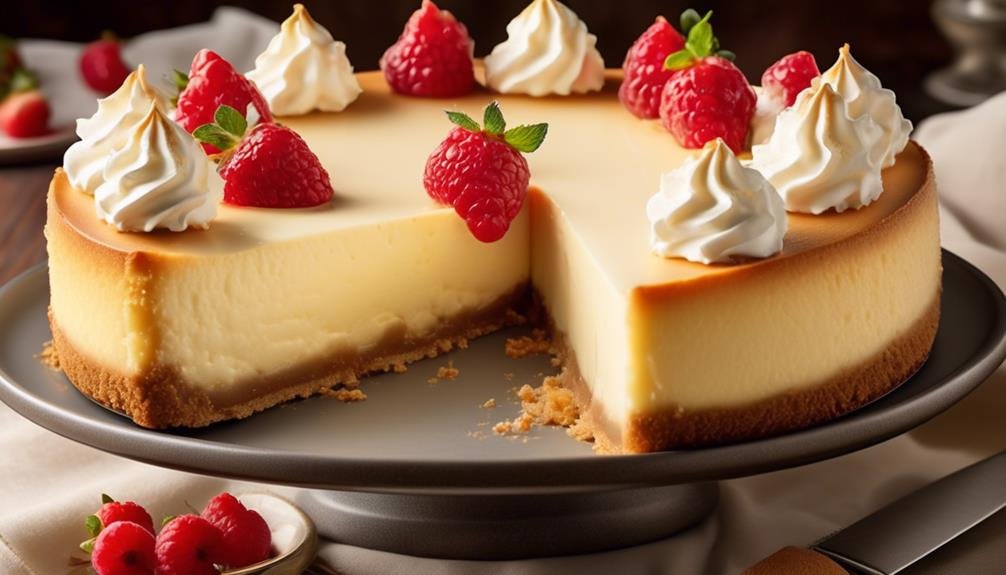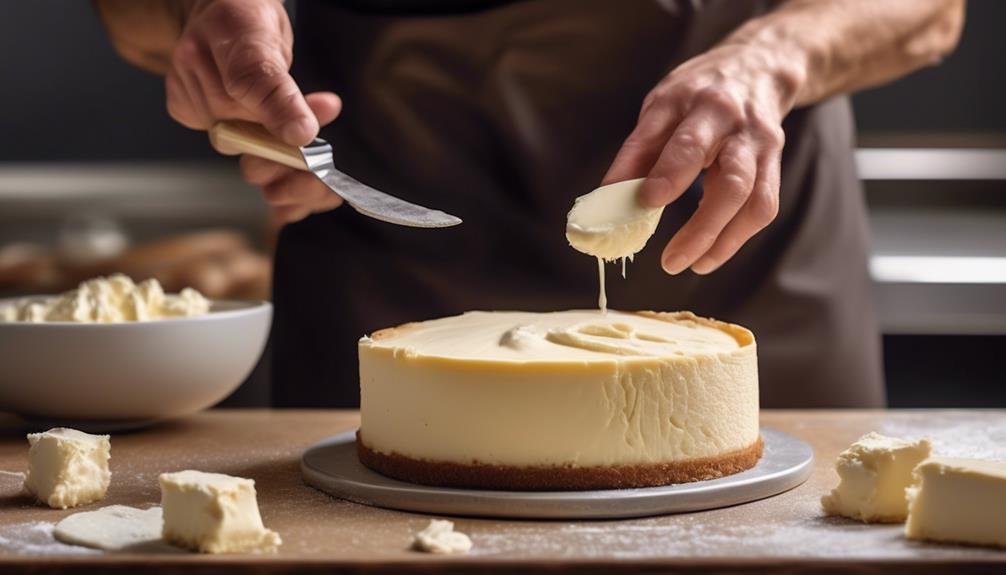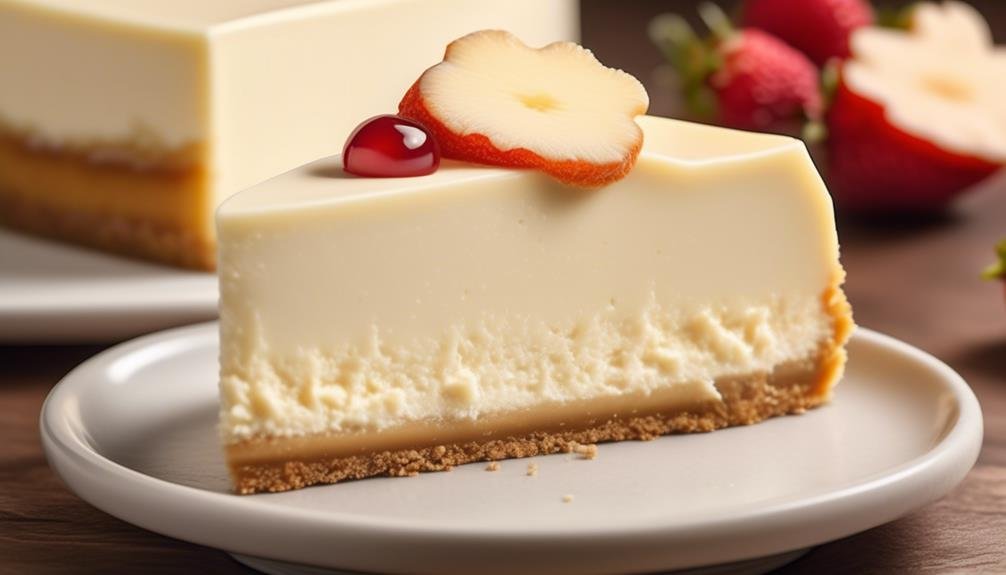Philadelphia Cream Cheese Cheesecake Recipes

If you've ever savored the creamy indulgence of a classic cheesecake, then you'll appreciate the rich and velvety texture that Philadelphia cream cheese brings to this timeless dessert.
Whether you're a seasoned baker or just beginning to explore the world of cheesecakes, there's something undeniably satisfying about mastering the art of creating the perfect cheesecake.
From mastering the graham cracker crust to achieving that faultless creamy filling, there's a world of tips, tricks, and variations waiting to be discovered.
So, let's uncover the secrets to crafting an impeccable Philadelphia Cream Cheese Cheesecake that will have your taste buds singing.
Classic Philadelphia Cheesecake Recipe
If you're craving a classic Philadelphia cheesecake that's rich, creamy, and indulgent, this recipe will guide you through the simple steps to create a delectable dessert.
Start by preheating the oven to 325°F.
Beat the Philadelphia cream cheese until smooth, then gradually add sugar and vanilla extract.
Beat in the eggs one at a time and pour the mixture into the graham cracker crust.
Bake the cheesecake for 55 minutes, then turn off the oven and leave the cheesecake inside for 1 hour before removing, cooling, and refrigerating for at least 4 hours before serving.
To serve, garnish with fresh fruits or chocolate sauce, slice into desired portions, and serve chilled with friends and family.
You can also experiment with variations such as adding lemon zest, swirling in fruit puree, or topping with caramel or toffee sauce.
Don't forget to try different crusts to find your favorite.
Additional tips include using a water bath, allowing the cheesecake to cool completely before removing from the springform pan, and the option to freeze the cheesecake for up to 2 months if desired.
Enjoy your homemade classic Philadelphia cheesecake!
Key Ingredients for Creamy Cheesecake
To create a creamy cheesecake, ensure you have the essential ingredients such as Philadelphia cream cheese, granulated sugar, eggs, vanilla extract, and graham cracker crumbs.
Philadelphia cream cheese is a key ingredient known for providing a rich and smooth texture to cheesecakes. It's a trusted product from a reputable food and beverage company, ensuring the quality and deliciousness of your dessert.
Granulated sugar sweetens the filling and balances the tanginess of the cream cheese, while eggs contribute to the structure and help set the filling for a creamy and firm texture.
Adding vanilla extract enhances the overall taste, making the cheesecake even more delightful.
Lastly, graham cracker crumbs are essential for the crust, providing a delicious base for the creamy cheesecake filling.
When combined, these ingredients not only create a delicious dessert but also offer a decent amount of nutrition.
As you gather these key ingredients, you're well on your way to making a mouthwatering, creamy cheesecake using trusted Philadelphia cream cheese.
How to Make Perfect Cheesecake

To make the perfect cheesecake, be sure to pay attention to the baking time and temperature.
Choose the right pan for even cooking.
Following these points will help you achieve a creamy, well-set cheesecake that will impress your guests.
Baking Time and Temperature
For the perfect cheesecake, preheat the oven to 325°F to ensure even cooking and a creamy texture.
When following a Philadelphia cheesecake recipe, it's crucial to maintain the preheated oven at 325°F (150°C) for consistent results.
Use a springform pan to bake the cheesecake for 55 minutes at this precise temperature, ensuring it sets perfectly.
After baking, remove the cheesecake from the oven and let it sit inside for an additional hour to set properly. This step is essential for achieving the ideal creamy texture.
Once out of the oven, allow the cheesecake to cool before refrigerating for at least 4 hours to chill and set completely.
Proper baking time and temperature are crucial to avoid over-drying or cracking, resulting in a flawless Philadelphia Cream Cheese cheesecake.
Choosing the Right Pan
Select a springform pan for easy removal of the cheesecake without damaging it. It's important to use a pan with a tight seal to prevent the batter from leaking during baking. Additionally, opt for a light-colored pan to evenly distribute heat and prevent over-browning. It's crucial to ensure the pan is the correct size as specified in the Philadelphia cream cheese cheesecake recipes to achieve the intended thickness of the cheesecake. Finally, consider using a water bath to regulate the temperature and protect the cheesecake from cracking during baking.
| Considerations | Recommendations |
|---|---|
| Pan Type | Springform pan for easy removal without damaging the cake |
| Seal | Use a pan with a tight seal to prevent batter leakage |
| Color | Opt for a light-colored pan to prevent over-browning |
| Size | Ensure the pan is the correct size as per the recipe |
Importance of Using a Water Bath
Using a water bath when baking a cheesecake is essential for achieving a smooth and crack-free dessert. The water bath helps regulate the temperature around the cheesecake, preventing cracking and ensuring a creamy texture. It also aids in even heat distribution, preventing overcooking of the outer edges and maintaining a moist texture, particularly crucial for custard-style cheesecakes.
This simple yet effective technique is vital for creating a visually appealing and perfectly baked cheesecake.
- Regulating Temperature:
- The water bath ensures that the oven's heat is gentle and uniform, preventing the cheesecake from cracking due to sudden temperature changes.
- Texture Perfection:
- By providing a moist and gentle heat environment, the water bath helps the Philadelphia cream cheese-based cheesecake recipes to achieve a creamy and tender texture throughout.
Using a water bath is like a protective shield for your cheesecake, making sure it bakes evenly and stays crack-free. It's a small step that makes a big difference in the final outcome of your delicious dessert.
Expert Tips for Cheesecake Success

To ensure a successful cheesecake, there are a few key factors to consider. First and foremost, be mindful of the baking time and temperature. This will help ensure that the cheesecake is cooked evenly and to perfection.
Additionally, it's important to pay attention to the consistency of both the crust and the filling. The crust should be firm and hold together well, providing a solid base for the creamy filling. The filling itself should be smooth and creamy, without any lumps or air bubbles.
Baking Time and Temperature
For successful cheesecake baking, preheat your oven to 325°F and use a water bath to prevent cracking.
When baking your Philadelphia cream cheese cheesecake, keep in mind the following tips for perfect results:
- Baking Time and Temperature:
- Preheat the oven to 325°F to ensure even baking and a creamy texture.
- Bake the cheesecake for 55 minutes, then leave it in the turned-off oven for an additional hour to set.
Maintaining the correct baking time and temperature is crucial in achieving the ideal texture and flavor for your cheesecake. By following these guidelines, you'll be on your way to creating a delectable Philadelphia cream cheese cheesecake that will impress all who indulge in it.
Crust and Filling Consistency
After ensuring the proper baking time and temperature for your Philadelphia cream cheese cheesecake, the next crucial step is achieving the ideal consistency for both the crust and the filling.
For the crust, aim for a firm but not overly hard texture. Pre-baking the crust can help achieve this by setting it and preventing sogginess.
When it comes to the filling, using room-temperature cream cheese and eggs ensures smooth and even blending, resulting in a consistent texture. Additionally, avoid overbaking, as this can lead to dryness and cracking.
To achieve the perfect filling consistency, consider using a water bath during baking for even heat distribution, which helps prevent cracking.
Remember to cool the cheesecake in the oven before chilling in the refrigerator for the best results.
Topping Ideas for Cheesecake
Looking to elevate your cheesecake experience? Try topping your creamy dessert with fresh fruits, decadent sauces, or crunchy toppings for an added burst of flavor and texture.
Here are some delectable topping ideas for your Philadelphia cream cheese cheesecake recipes:
- Fresh fruits like strawberries, raspberries, or blueberries for a burst of flavor and color. These fruits not only enhance the visual appeal of your cheesecake but also add a natural sweetness and a pop of color, making your dessert look as appetizing as it tastes.
- Drizzling chocolate or caramel sauce over the cheesecake for a decadent touch. Indulge in the richness of chocolate or caramel, elevating the creamy cheesecake with a luxurious, velvety finish.
Whether you choose to add a fruity twist, a touch of decadence, or an element of crunch, these topping ideas will take your cheesecake to the next level, creating a high-quality dessert fit for various eating occasions.
Experiment with different toppings to find your perfect combination and elevate your Philadelphia cream cheese cheesecake to a whole new level of deliciousness.
Philadelphia Vs. New York Cheesecake Differences

When comparing Philadelphia and New York cheesecakes, consider the distinct differences in texture and flavor resulting from the use of cream cheese and sour cream in their respective recipes.
Philadelphia cheesecake, made with cream cheese, has a tangy and creamy flavor, while New York cheesecake, often incorporating sour cream or heavy cream, boasts a denser and richer texture.
The Philadelphia style is known for its lighter and fluffier texture, whereas New York cheesecake is renowned for being denser and creamier. This is due to the use of sour cream in the New York recipe, which gives it a thicker and heavier filling compared to the airier consistency of Philadelphia cheesecake.
Another notable distinction is the presentation; New York cheesecake is traditionally served without any toppings, highlighting its rich simplicity, while Philadelphia cheesecake is often adorned with fruit or sauce, adding a touch of vibrant sweetness.
These differences in texture, flavor, and presentation make the choice between the two styles a matter of personal preference, with both Philadelphia and New York cheesecakes offering delightful indulgences for food enthusiasts.
Frequently Asked Questions
What's the Difference Between New York Style Cheesecake in Philadelphia Style Cheesecake?
New York style cheesecake has a richer, thicker filling with heavy cream or sour cream, while Philadelphia style uses only cream cheese for a lighter, tangier flavor. New York has a denser crust, bakes at a higher temperature, while Philadelphia style has a graham cracker crust, bakes at a lower temperature.
What Makes New York Cheesecake Different Than Regular Cheesecake?
New York cheesecake is a velvety delight with its creamy texture and rich flavor. It differs from regular cheesecake in its thicker, graham cracker crust, savory tang from added cream, and the use of a water bath for baking.
How Do You Thicken Philadelphia Cheesecake Filling?
To thicken Philadelphia cheesecake filling, let the cream cheese warm up, gradually add sugar, beat in eggs one at a time, consider adding flour, and refrigerate for at least 4 hours for a creamy, thick texture.
Can You Eat Philadelphia No Bake Cheesecake Filling?
Yes, you can eat Philadelphia no-bake cheesecake filling. It's safe to consume without baking, made with cream cheese and sugar. Refrigerate for ideal texture. Enjoy as is or in dessert recipes, following food safety guidelines.

Related Posts